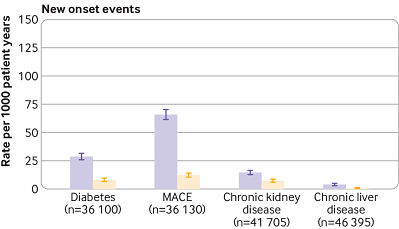“Long Covid” – Could this be triggering diabetic conditions?

We are beginning to understand that “Long Covid” - or “Post-Covid-19 syndrome” - is not one condition with the National Institute for Health and Care Excellence (NICE) describing it as “signs and symptoms that develop during or after an infection consistent with Covid-19 which continue for more than 12 weeks and are not explained by an alternative diagnosis.”
One of these signs and symptoms is connected to diabetes. We knew fairly early on that people with diabetes were at greater risk of developing Covid-19 and of experiencing more serious respiratory problems.
However, it has been observed that some people with pre-existing diabetes have subsequently presented with complications such as diabetic ketoacidosis or hyperosmolar hyperglycaemia state. It has also been noted that diabetes is newly occurring in post Covid-19 patients.
About Ketoacidosis
This occurs when insufficient insulin causes the body to break down fat as fuel which then leads to a build-up of acids in the bloodstream called ketones. This is serious since untreated diabetic ketoacidosis can lead to loss of consciousness and fatality.
Signs of this condition include excessive thirst, frequent urination, nausea and vomiting, stomach pain, weakness or fatigue, shortness of breath, fruity-scented (pear-drops) breath, and confusion. I talk about the condition more fully here
It is perhaps not surprising that this condition might occur post Covid-19 infection given that its triggers are recent illness or stress. So, in this respect my main message is to frequently check your blood sugars if you have recently had COVID but get medical help if you are experiencing these symptoms
However, it may be that Covid-19 is specifically triggering this and I talk about this under the heading Post-Covid
About Hyperosmolarity
In diabetic hyperosmolar hyperglycaemia syndrome, your body tries to rid itself of the excess blood sugar by passing it into your urine. Urination will then occur much more frequently which then leads to dehydration over weeks rather than days.
Signs of dehydration include extreme thirst, weakness, dry skin, changes in vision, cramping in the legs and signs of confusion.
There are no ketones in the blood however, like ketoacidosis, this condition is a sign that your diabetes is not under control and can occur after an illness.
It is less common that ketoacidosis and is more frequently seen in ethnic minorities and those aged over 70 years.
Left untreated, diabetic hyperosmolar hyperglycaemia syndrome can lead to life-threatening dehydration. So again, my main message to you is to frequently check your blood sugars if you have recently had Covid-19 but get medical help if you are experiencing these symptoms
However, it may be that Covid-19 is specifically triggering this and I talk about this below
New onset diabetes
A March 2021 study of nearly 48,000 people was conducted “to quantify rates of organ specific dysfunction in individuals with Covid-19 after discharge from hospital compared with a matched control group from the same general population”
This showed the increased likelihood of new onset diabetes as indicated in the chart below. (MACE stands for a major adverse cardiovascular event)

Key: Blue – People with Covid-19 Orange – Controls
We also know that, compared with a typical year, it has already been noted that there has been an increased number of new type 1 diabetes cases in UK children.
I discuss types 1 and 2 diabetes here
If you recognise any of the symptoms you should contact your GP.
Post Covid-19
We are already aware that SARS – another Coronavirus – saw the virus binding to ACE2 receptors causing an alteration in the glucose metabolism. One theory is that this leads to inflammatory damage to the beta cells (β-cells) – these are a type of cell found in pancreatic islets that synthesise and secrete insulin and amylin
This event could cause cytokines to be released as part of the inflammatory response and a triggering of the autoimmune response.
There are still many questions to address regarding diabetic conditions post Covid-19 including:
- The frequency of new-onset diabetes, and is it classic type 1 or type 2 diabetes or a new type of diabetes?
- The likelihood of people remaining at higher risk for diabetes or diabetic ketoacidosis
- Whether Covid-19 changes the underlying pathophysiology and the natural history of the disease in people with pre-existing diabetes?
In order to rapidly share global knowledge in this area of medicine an international group of leading diabetes researchers are participating in a project called CoviDIAB
The goal of this is to establish a global registry of people with Covid-19 related diabetes to establish the extent of the problem and to gain clues regarding the appropriate care for patients during and after Covid-19. It is great to see such an initiative get underway
I hope this has been helpful.
If you would like to read about this subject in more detail please see the links below
https://www.ncbi.nlm.nih.gov/pmc/articles/PMC7765692/
https://www.ncbi.nlm.nih.gov/pmc/articles/PMC7304415/
https://www.ncbi.nlm.nih.gov/pmc/articles/PMC8313068/
Although every effort is made to ensure that all health advice on this website is accurate and up to date it is for information purposes and should not replace a visit to your doctor or health care professional.
As the advice is general in nature rather than specific to individuals Dr Vanderpump cannot accept any liability for actions arising from its use nor can he be held responsible for the content of any pages referenced by an external link
If you would like to read more on this subject please see:










